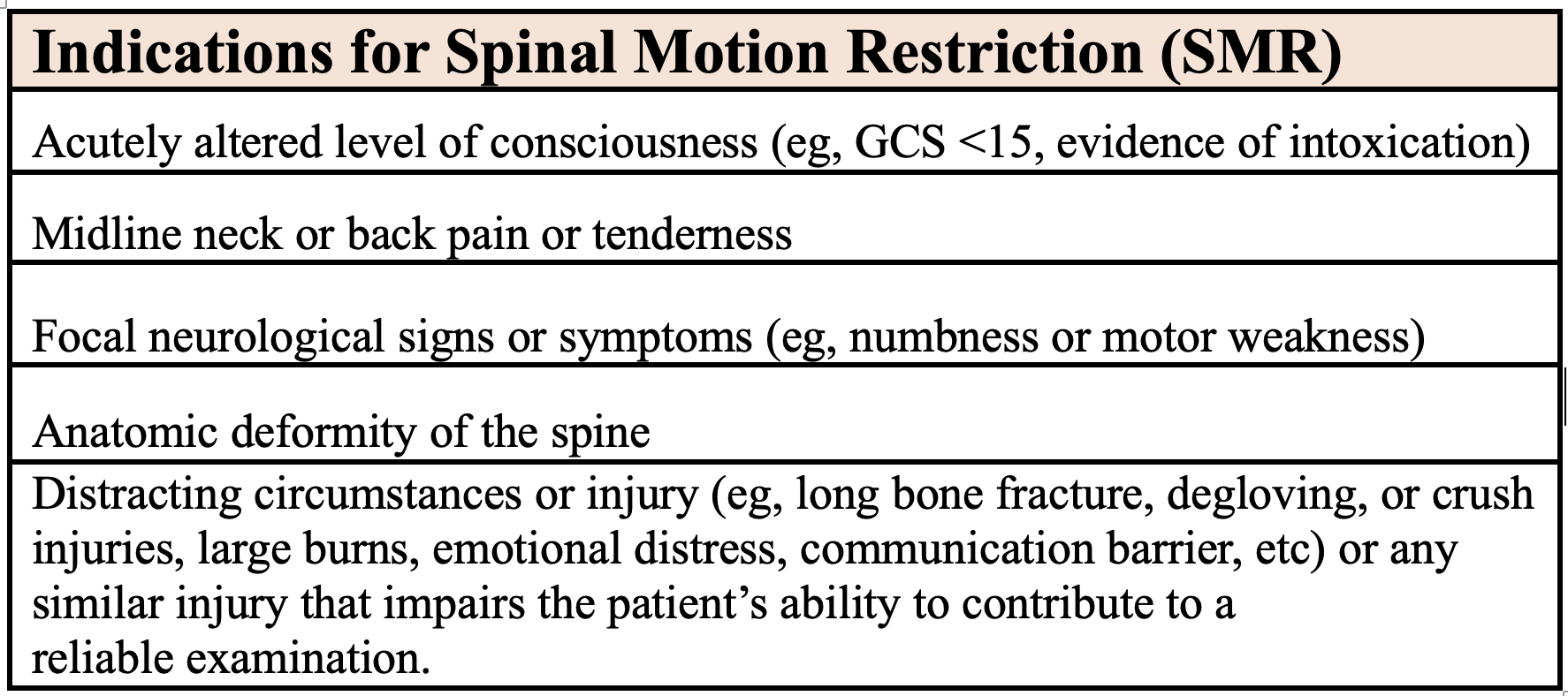[1]
White CC 4th, Domeier RM, Millin MG, Standards and Clinical Practice Committee, National Association of EMS Physicians. EMS spinal precautions and the use of the long backboard - resource document to the position statement of the National Association of EMS Physicians and the American College of Surgeons Committee on Trauma. Prehospital emergency care. 2014 Apr-Jun:18(2):306-14. doi: 10.3109/10903127.2014.884197. Epub 2014 Feb 21
[PubMed PMID: 24559236]
[2]
Velopulos CG, Shihab HM, Lottenberg L, Feinman M, Raja A, Salomone J, Haut ER. Prehospital spine immobilization/spinal motion restriction in penetrating trauma: A practice management guideline from the Eastern Association for the Surgery of Trauma (EAST). The journal of trauma and acute care surgery. 2018 May:84(5):736-744. doi: 10.1097/TA.0000000000001764. Epub
[PubMed PMID: 29283970]
[3]
Papadopoulos MC, Chakraborty A, Waldron G, Bell BA. Lesson of the week: exacerbating cervical spine injury by applying a hard collar. BMJ (Clinical research ed.). 1999 Jul 17:319(7203):171-2
[PubMed PMID: 10406758]
[4]
Ham HW,Schoonhoven LL,Schuurmans MM,Leenen LL, Pressure ulcer development in trauma patients with suspected spinal injury; the influence of risk factors present in the Emergency Department. International emergency nursing. 2017 Jan;
[PubMed PMID: 27450044]
[5]
Edlich RF, Mason SS, Vissers RJ, Gubler KD, Thacker JG, Pharr P, Anderson M, Long WB 3rd. Revolutionary advances in enhancing patient comfort on patients transported on a backboard. The American journal of emergency medicine. 2011 Feb:29(2):181-6. doi: 10.1016/j.ajem.2009.08.027. Epub 2010 Mar 25
[PubMed PMID: 20825784]
Level 3 (low-level) evidence
[6]
Sparke A, Voss S, Benger J. The measurement of tissue interface pressures and changes in jugular venous parameters associated with cervical immobilisation devices: a systematic review. Scandinavian journal of trauma, resuscitation and emergency medicine. 2013 Dec 3:21():81. doi: 10.1186/1757-7241-21-81. Epub 2013 Dec 3
[PubMed PMID: 24299024]
Level 1 (high-level) evidence
[7]
Totten VY, Sugarman DB. Respiratory effects of spinal immobilization. Prehospital emergency care. 1999 Oct-Dec:3(4):347-52
[PubMed PMID: 10534038]
[8]
Walsh M,Grant T,Mickey S, Lung function compromised by spinal immobilization. Annals of emergency medicine. 1990 May;
[PubMed PMID: 2331117]
[9]
Castro-Marin F, Gaither JB, Rice AD, N Blust R, Chikani V, Vossbrink A, Bobrow BJ. Prehospital Protocols Reducing Long Spinal Board Use Are Not Associated with a Change in Incidence of Spinal Cord Injury. Prehospital emergency care. 2020 May-Jun:24(3):401-410. doi: 10.1080/10903127.2019.1645923. Epub 2019 Aug 14
[PubMed PMID: 31348691]
[10]
Pieretti-Vanmarcke R, Velmahos GC, Nance ML, Islam S, Falcone RA Jr, Wales PW, Brown RL, Gaines BA, McKenna C, Moore FO, Goslar PW, Inaba K, Barmparas G, Scaife ER, Metzger RR, Brockmeyer DL, Upperman JS, Estrada J, Lanning DA, Rasmussen SK, Danielson PD, Hirsh MP, Consani HF, Stylianos S, Pineda C, Norwood SH, Bruch SW, Drongowski R, Barraco RD, Pasquale MD, Hussain F, Hirsch EF, McNeely PD, Fallat ME, Foley DS, Iocono JA, Bennett HM, Waxman K, Kam K, Bakhos L, Petrovick L, Chang Y, Masiakos PT. Clinical clearance of the cervical spine in blunt trauma patients younger than 3 years: a multi-center study of the american association for the surgery of trauma. The Journal of trauma. 2009 Sep:67(3):543-9; discussion 549-50. doi: 10.1097/TA.0b013e3181b57aa1. Epub
[PubMed PMID: 19741398]
[11]
Hale DF, Fitzpatrick CM, Doski JJ, Stewart RM, Mueller DL. Absence of clinical findings reliably excludes unstable cervical spine injuries in children 5 years or younger. The journal of trauma and acute care surgery. 2015 May:78(5):943-8. doi: 10.1097/TA.0000000000000603. Epub
[PubMed PMID: 25909413]
[12]
Cooney DR,Wallus H,Asaly M,Wojcik S, Backboard time for patients receiving spinal immobilization by emergency medical services. International journal of emergency medicine. 2013 Jun 20;
[PubMed PMID: 23786995]
[13]
Haut ER, Kalish BT, Efron DT, Haider AH, Stevens KA, Kieninger AN, Cornwell EE 3rd, Chang DC. Spine immobilization in penetrating trauma: more harm than good? The Journal of trauma. 2010 Jan:68(1):115-20; discussion 120-1. doi: 10.1097/TA.0b013e3181c9ee58. Epub
[PubMed PMID: 20065766]
[14]
McDonald N, Kriellaars D, Weldon E, Pryce R. Head-Neck Motion in Prehospital Trauma Patients under Spinal Motion Restriction: A Pilot Study. Prehospital emergency care. 2021 Jan-Feb:25(1):117-124. doi: 10.1080/10903127.2020.1727591. Epub 2020 Mar 18
[PubMed PMID: 32045315]
Level 3 (low-level) evidence
[15]
Spooner AJ, Corley A, Sharpe NA, Barnett AG, Caruana LR, Hammond NE, Fraser JF. Head-of-bed elevation improves end-expiratory lung volumes in mechanically ventilated subjects: a prospective observational study. Respiratory care. 2014 Oct:59(10):1583-9. doi: 10.4187/respcare.02733. Epub 2014 May 20
[PubMed PMID: 24847096]
Level 2 (mid-level) evidence
[16]
Wang H,Coppola M,Robinson RD,Scribner JT,Vithalani V,de Moor CE,Gandhi RR,Burton M,Delaney KA, Geriatric Trauma Patients With Cervical Spine Fractures due to Ground Level Fall: Five Years Experience in a Level One Trauma Center. Journal of clinical medicine research. 2013 Apr;
[PubMed PMID: 23519239]

